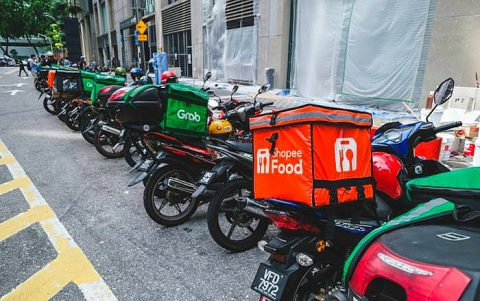E-commerce promotes economic recovery after the pandemic
- 106
- Digital
- 14:28 23/05/2022
DNHN - Proposing solutions to recover after the Covid-19 pandemic and the potential of the e-commerce market, the Vietnam e-commerce landscape 2022 forum taking place in Ho Chi Minh City on May 10 attracted more than 1,000 professionals and participating businesses.

According to the Department of E-commerce and Digital Economy, Ministry of Industry and Trade, Vietnam's e-commerce market is experiencing explosive growth.
The strong increase in the number of new consumers and the increasing demand for shopping on e-commerce platforms has attracted a large number of sellers to participate in this market in 2021. Especially, when business activity was interrupted for nearly four months due to social distancing in provinces and cities, "joining the e-commerce platform" has become a strategic solution for many brands and sellers.
The report of Vietnam's e-commerce market in the first half of 2022, extracted from the Metric.vn data platform of Data Science Joint Stock Company, shows that in the context of Vietnam's e-commerce sector in the post-Covid-19 period. Vietnam is becoming the second largest e-commerce market in Southeast Asia, after Indonesia.
Brands and sellers on Vietnam's e-commerce floors are concentrated mainly in two big cities, Hanoi and Ho Chi Minh City. Sales of international sellers are also growing rapidly after only two big cities in Vietnam because the exchanges have begun to expand with international products.
Speaking at the discussion session with the theme "Signs of global recovery", Mr. Nguyen Tan Vuong, Senior Manager of NielsenIQ Vietnam Co., Ltd., said that the impact of Covid-19 has accelerated the growth of e-commerce and consumers tend to choose healthcare products. It is notable that the trend of multi-channel shopping has experienced remarkable growth, the most among consumers recovering from the pandemic.
From the perspective of an e-commerce platform, Ms. Pham Thi Quynh Trang, Commercial Director of Lazada Vietnam, said that during the pandemic, it is a bridge to accelerate the speed of digital transformation, connecting the broken market. In Vietnam, up to 85% of Vietnamese consumers spend more on online shopping since the outbreak of the pandemic. With that momentum, e-commerce will continue to grow and contribute to economic recovery after the pandemic.
As one of the young, pioneering enterprises in the field of gold, silver and gems in innovation, HanaGold has applied e-commerce in business activities to promote products, brands and combine it with other activities to effectively deliver a unique experience to consumers.
As a result, HanaGold has attracted a lot of customers who are interested. Although sales from e-commerce have not met expectations, there have been signs of growth.
With the potential for digital transformation along with the need to use and invest in gold, Hana Gold quickly seized the opportunity to develop the gold industry in Vietnam in an improved way compared to the traditional one, creating a breakthrough for the gold trading industry in Vietnam and reaching out to internationalization.
HanaGold will explode with development strategies to achieve the goal of 500 agents and collaborators selling online, spreading the brand as well as product quality.
Assessing the opportunities for businesses to export products through e-commerce, Mr. Nguyen Ngoc Dung, Chairman of the Vietnam E-commerce Association, said that many Vietnamese products have been introduced to the world through e-commerce platforms.
Through large international trading platforms such as Amazon or Alibaba, Vietnamese businesses, especially small and medium enterprises, can reach hundreds of millions of customers in many countries.
In addition to major international e-commerce sites, recently, a number of domestic e-commerce sites have also strongly promoted the export of Vietnamese goods, especially agricultural products.
However, the difficulty of exporting through e-commerce is not from technology problems, but the problem of knowledge and procedures for foreign trade activities is also a limit ation for many businesses, so many good products are not accessible to international consumers.
Offering experiential products, finding featured products, and producing products that international consumers are interested in are issues being raised for businesses.
Source Customsnews
Related news
- CICON expands strategic alliances: A new step forward in Vietnam–Korea business connectivity
- What must Vietnamese enterprises do to maintain their position in the global supply chain?
- Vietnam advances cybersecurity law to boost digital sovereignty and business resilience
- Vietnam embraces digital tools to modernize public administration
- Administrative procedures for establishing the national technology exchange reduced to one application set
- Vietnam hits highest FDI inflow since 2009, fuels industrial real estate boom
- Foreign investors expected to open 150,000 new securities accounts in the next 5 years
- Government’s plan to implement Law on Digital Technology Industry approved
- Vietnam launches “Private Economy Panorama Model” to foster public-private national development
- Shark Nguyễn Hòa Bình: Hanoi will become the capital of startup innovation.
- Deputy Prime Minister Lê Thành Long meets with Osaka Governor Yoshimura Hirofumi to promote Vietnam–Japan cooperation.
- The master sales secrets of luxury king Bernard Arnault that make the world spend
- White House: When politics and technology join forces to rewrite the global AI order
- Da Nang proposes semiconductor cooperation with Oregon (USA)
- Quang Tri calls for investment in wind power plant project worth over VND 1,100 billion
- Hanoi receives two million visitors during the four-day National Day holidays
- Multiple MoUs signed in Da Nang to boost semiconductor development
- UNDP Resident Representative hails Vietnam as an emerging economic powerhouse
- How the UAE Transformed from Oil Wealth to AI Leadership?
- Success in business is always a human story
Đọc thêm Digital
Vietnam advances cybersecurity law to boost digital sovereignty and business resilience
In a significant step towards strengthening Vietnam’s digital defenses, the National Assembly Standing Committee convened on September 23 to review the draft revised Cybersecurity Law.
Vietnam embraces digital tools to modernize public administration
Across Vietnam, local governments are turning to digital platforms, QR codes, and AI-powered assistants to modernize public services—making them faster, more transparent, and more accessible to citizens.
Administrative procedures for establishing the national technology exchange reduced to one application set
Deputy Prime Minister Nguyen Hoa Binh has just signed Decision No. 2108/QD-TTg approving the plan to streamline internal administrative procedures within the state administrative system under the management of the Ministry of Science and Technology.
Government’s plan to implement Law on Digital Technology Industry approved
The Government has approved a plan to implement the Law on Digital Technology Industry (the Law) scheduled to take effect from January 1, 2026, according to a report from the Government News.
Shark Nguyễn Hòa Bình: Hanoi will become the capital of startup innovation.
Recently, in Hanoi, the seminar “Formulating City People’s Council Resolutions to Promote Science and Technology Development in Connection with the Implementation of Politburo Resolution No. 57-NQ/TW and the Capital Law No. 39/2024/QH15” was held.
Da Nang proposes semiconductor cooperation with Oregon (USA)
Leaders of Da Nang City have proposed that Oregon (USA) and the city explore cooperation opportunities in priority sectors such as semiconductor technology, logistics, and the development of Free Trade Zone (FTZ) infrastructure.
How the UAE Transformed from Oil Wealth to AI Leadership?
Once famed as the Gulf’s “oil brain,” the United Arab Emirates (UAE) is now redefining its global standing, emerging as one of the top three nations in artificial intelligence (AI), trailing only behind the United States.
ShopeeFood and Grab dominate Vietnam’s food delivery market
As 2025 begins, Vietnam’s food delivery market is expected to remain highly concentrated, with only a few platforms dominating the space unless new players enter the fray.
E-commerce in 2025: Explosive opportunities amid fierce competition
E-commerce in Vietnam continues to grow rapidly but faces intense competition and rising costs, forcing businesses to optimize strategies and technologies to maintain profitability.
The potential of the blockchain and cryptocurrency
Globally, the cryptocurrency market has seen significant growth. In Vietnam, despite not being officially recognized, cryptocurrencies like Bitcoin, Ethereum, Litecoin, and Ripple have emerged and are actively traded.











